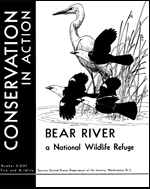United States Fish and Wildlife Service

United States Fish and Wildlife Service: Publications
Date of this Version
6-2007
Citation
U.S. Fish and Wildlife Service June 2007.
Abstract
Executive Summary
The term “light geese” refers collectively to three taxa of geese that have light coloration: greater snow geese, Ross’s geese, and lesser snow geese. Various light goose populations in North America have experienced rapid population growth, and have reached levels such that they are damaging habitats on their arctic and subarctic breeding areas. Habitat degradation in arctic and subarctic areas may be irreversible, and has negatively impacted light goose populations and other bird populations dependent on such. Natural marsh habitats on some migration and wintering areas also have been impacted by light geese. In addition, goose damage to agricultural crops has become a problem. There is increasing evidence that lesser snow and Ross’s geese act as reservoirs for the bacterium that causes avian cholera. The threat of avian cholera to other bird species likely will increase as light goose populations expand. The management goal for light geese in the mid-continent region is to reduce the population by 50% from the level observed in the late 1990s. The management goal for greater snow geese is to reduce the population to 500,000 birds. We believe these population levels are more compatible with the ability of habitats to support them. This document describes various alternatives for the purpose of reducing and stabilizing specific populations of light geese in North America. We analyzed five management alternatives: A) no action; B) modify harvest regulation option and refuge management (PREFERRED); C) implement direct agency control of light goose populations on migration and wintering areas in the U.S.; D) seek direct light goose population control on breeding grounds in Canada; E) two-phased approach to light goose population control. Phase one of alternative E is identical to alternative B, whereas phase two includes elements of alternatives C and D. Under Alternative E, if implementation of phase one was not successful in reducing light goose populations we would assess the need to implement phase two. Alternatives were analyzed with regard to their potential impacts on light geese, other bird species, special status species, socioeconomics, historical resources, and cultural resources.

